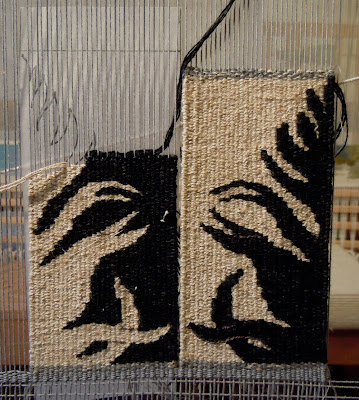January was a month of challenges. I left home for about two weeks early in the month when we had trees cut at our house. Lots of trees. About 50 trees. They were Leland Cypress trees and we planted them in 1996. In the years since they'd grown to over 40 feet high and were a wonderful, lush green screening around our back yard. Until a year or so ago when they started dying. According to a person supposedly in the know about tree life and death, the disease that was effecting them couldn't be arrested at this point. So we had to take them out.
Trees have been one of my themes in art work for many years now. It hurt my heart to know these trees were beyond saving and so, as a Hambidge Fellow, I was able to arrange a stay at Hambidge Center even through it isn't official residency season there during the winter. That way I was able to leave town, leaving my husband to listen to the chain saws and chipper that ran for about a week. Yes, I know, one can't always run away from what's unpleasant and hurtful. This time, however, I did.
My stay at Hambidge was very, very good. I was able to complete some things that needed to be done--both weaving and writing tasks. The stay there was interrupted for a long weekend when I came home so my husband and I could travel to Nashville to see the Howard Finster exhibit there before it ended. Then I went back to Hambidge for almost another week. Oh -- and there was a trip to Asheville thrown in there when I went to the Southern Highland Craft Guild's Folk Art Center for a meeting in the middle of the month.
And the John Campbell Folk School class that I wrote about several days ago happened at the end of January. When I counted the away days in the tapestry diary I found that I was gone for 17 out of the 31 days of January. What a way to start off the new year--more days away than at home!
So here are a few things that are happening that are new directions for me and that the challenging month of January helped to bring about. First, this piece that was done while at Hambidge:

The trees, of course, aren't new subject matter but the technique is, for me. The "windows" that are in color are woven in twice the sett as the background natural color area. I've never done more than a little bit of sampling with splitting the sett before but wanted to tackle it for this weaving. Another difference with this piece, also, is that I didn't use a cartoon. I had loose sketches of trees that I'd do each day while at Hambidge and I'd look at the sketch as it lay nearby to do the weaving. The shapes, of course, are quite simplified and so that was possible to do quite easily. The sett for the tree areas is 8 epi and the background/border area is about 4 epi. The natural color is 12/18 cotton seine twine used two fold, in fact. I didn't have white or natural wools with me so used what I had. And I liked the roughness and boldness of the seine twine--an interesting contrast to the more delicate wool for the landscape/tree areas.
A second new direction is to follow up with the ideas that began to percolate while at the Folk School... the use of soumak to make linear effects in the tapestry. I'd tried it out on a simplified tree that I showed in the earlier post but yesterday I decided to try it with some of my drawings of feathers.
I've got quite a few drawings of feathers in my sketchbooks and I decided to use tracing paper to copy basic lines from a few of those and to combine them to use as a cartoon. I'm using soumak to "draw" the lines and a natural color as the background for the lines. The sett is 10 epi of 12/6 gray cotton seine twine and the weft is several strands of linen/silk for the natural color and the same + a sort of graphite gray mercerized cotton as the line color. I wove the first feather in about 3 hours today and I'm hoping to be able to weave the second one tomorrow.


All of these things make me happy... new directions to explore in my work and, I hope, a fresh way to look at what I choose to weave. I learned while at my class at the Folk School that my work was rejected from the ATB9 exhibit but this time around I simply do not care. I have less and less regard for the ability of jurors to make selections than I once did. I hope my work will continue to grow and change and I have always chosen to enter whatever is my current concepts and approach. Perhaps that isn't a good way to do it but that's my choice. So, when ATB10 rolls around, maybe I'll enter or maybe not. But I will always know that I am not weaving for a juror... I am weaving what needs to be done--from my heart.
P.S. Check out Kathe Todd-Hooker's books, Line in Tapestry, Shaped Tapestry, and Tapestry 101 for lots of great info about a variety of methods for adding zest to your tapestry!
































